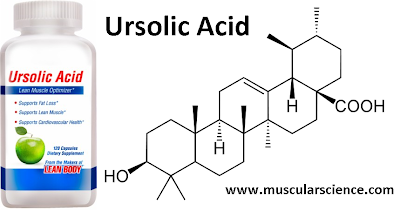Updated: September 28 2013
What is It?Ursolic acid (urson, prunol, malol) is phytochemical (pentacyclic triterpene acid) used in cosmetics and is found in many plants, especially apples. [20,21] It is believed to be able to increase muscle mass, control estrogen, increase energy, and decrease fat mass at the same time.
Sources of Ursolic Acid
Ursolic acid is found naturally in apples (in the peel), basil, bilberries, cranberry juices, elder flower, peppermint, rosemary, lavender, oregano, thyme, hawthorn, Mirabilis jalapa, and prunes.
Pharmacology
1. Bioavailability/absorption: oral: 15-20%; very poor oral absorption in rats. [3,4]
2. Half-life: about 4 hours in rats. [4]
3. Mechanism of action:
What Do Human Research Studies Say?
Lack of studies.
What Do Animal/Tissue Culture Research Studies Say?
1. Increase atheroma formation (cause atherosclerosis); this is by acceleration of artherogenic plaque formation. [5,6] This is unreliable because at lower doses it protected the mice against atherosclerosis. [7]
2. Augments insulin's actions on the insulin receptor, stimulating glucose uptake and decreasing glucose level in rats/tissue cultures. [8-15]
3. Acts as an anti-diabetic agents and reduce glucose level in mice. [7,16-19]
Conclusion
Due to lack of human studies, it cannot be recommended for now, even though it seems promising.
Verdict: No need to be added to your supplement stackRecommended Dosage (Used in the Studies)
1. Due to lack of human studies, no recommended dose can be established.
2. According to animal studies: 2 mg to 7 mg /kg bodyweight.
Where Can You Buy This Supplement?
Amazon.com
Side Effects of This Supplement
1. Ursolic acid has no known side effects after human supplementation at this moment.
2. According to animal studies: impotence by inhibiting spermatogenesis. [1] and reduction of sperm motility. [2]
References
1. Ursolic acid generates symplasts in rat spermatogenic clones
2. A potent sperm motility-inhibiting activity of bioflavonoids from an ethnomedicine of Onge, Alstonia macrophylla Wall ex A. DC, leaf extract.
3. Permeability of rosmarinic acid in Prunella vulgaris and ursolic acid in Salvia officinalis extracts across Caco-2 cell monolayers.
4. LC-MS determination and pharmacokinetic studies of ursolic acid in rat plasma after administration of the traditional chinese medicinal preparation Lu-Ying extract.
5. Ursolic acid causes DNA-damage, p53-mediated, mitochondria- and caspase-dependent human endothelial cell apoptosis, and accelerates atherosclerotic plaque formation in vivo.
6. Diet and atherosclerosis in apolipoprotein E-deficient mice.
7. Ursolic acid protects diabetic mice against monocyte dysfunction and accelerated atherosclerosis.
8. Ursolic acid and its derivative inhibit protein tyrosine phosphatase 1B, enhancing insulin receptor phosphorylation and stimulating glucose uptake
9. Inhibition of protein tyrosine phosphatase 1B by ursane-type triterpenes isolated from Symplocos paniculata.
10. Protein tyrosine phosphatase 1B inhibitory by dammaranes from Vietnamese Giao-Co-Lam tea.
11. Inhibitory effect of chalcones and their derivatives from Glycyrrhiza inflata on protein tyrosine phosphatase 1B.
12. Identification of Tyrosine Phosphatases That Dephosphorylate the Insulin Receptor
13. Increased insulin sensitivity and obesity resistance in mice lacking the protein tyrosine phosphatase-1B gene.
14. Insulin-mimetic and insulin-sensitizing activities of a pentacyclic triterpenoid insulin receptor activator.
15. mRNA expression signatures of human skeletal muscle atrophy identify a natural compound that increases muscle mass.
16. alpha-Amylase inhibitory activity of some Malaysian plants used to treat diabetes; with particular reference to Phyllanthus amarus.6. Diet and atherosclerosis in apolipoprotein E-deficient mice.
7. Ursolic acid protects diabetic mice against monocyte dysfunction and accelerated atherosclerosis.
8. Ursolic acid and its derivative inhibit protein tyrosine phosphatase 1B, enhancing insulin receptor phosphorylation and stimulating glucose uptake
9. Inhibition of protein tyrosine phosphatase 1B by ursane-type triterpenes isolated from Symplocos paniculata.
10. Protein tyrosine phosphatase 1B inhibitory by dammaranes from Vietnamese Giao-Co-Lam tea.
11. Inhibitory effect of chalcones and their derivatives from Glycyrrhiza inflata on protein tyrosine phosphatase 1B.
12. Identification of Tyrosine Phosphatases That Dephosphorylate the Insulin Receptor
13. Increased insulin sensitivity and obesity resistance in mice lacking the protein tyrosine phosphatase-1B gene.
14. Insulin-mimetic and insulin-sensitizing activities of a pentacyclic triterpenoid insulin receptor activator.
15. mRNA expression signatures of human skeletal muscle atrophy identify a natural compound that increases muscle mass.
17. Ursolic acid and rosiglitazone combination alleviates metabolic syndrome in high fat diet fed C57BL/6J mice.
18. Inhibitory effects of ursolic acid on hepatic polyol pathway and glucose production in streptozotocin-induced diabetic mice.
19. Anti-glycative effects of oleanolic acid and ursolic acid in kidney of diabetic mice
20. Ursolic acid inhibits nuclear factor-kappaB activation induced by carcinogenic agents through suppression of IkappaBalpha kinase and p65 phosphorylation: correlation with down-regulation of cyclooxygenase 2, matrix metalloproteinase 9, and cyclin D1
21. Ursolic acid inhibits STAT3 activation pathway leading to suppression of proliferation and chemosensitization of human multiple myeloma cells
| © Muscular Science 2013 |

